Once upon a time here on Needle ‘n Thread, I distinguished between “bead embroidery” and “embroidery with beads.” I’m not really sure if there’s an official distinction, but if there isn’t, I think there should be (just for the sake of clarity).
And just for the sake of clarity, when I’m writing about beads and embroidery, I tend to think of “bead embroidery” as embroidery that is done entirely with beads. Take, for example, these beautiful bead embroidery kits by Mary Alice Sinton at Blue Bonnet Studio. Exquisite! And entirely beaded.
When I think of “embroidery with beads,” on the other hand, I think of work that is predominantly thread-executed embroidery, accented with beads.
I like both. (Who am I kidding? I love both!) There’s just something that appeals to me about the sparkle of beads.
But most frequently, when I’m playing with beads, I indulge in the latter – embroidery with beads.
Incidentally, neither of these should be confused with beading – creating jewelry or other structures, usually devoid of fabric and relying only on thread or wire as the structure, entirely from beads. Nor should either be confused with weaving with beads. Both of these are entirely different from embroidery, or the embellishment of fabric, with beads (even if some beading can involve fabric and weaving results in a kind of fabric…)
Confusing enough? Well, for today’s topic, let’s just stick with the notion of embellishing fabric with embroidery that is accented with beads.
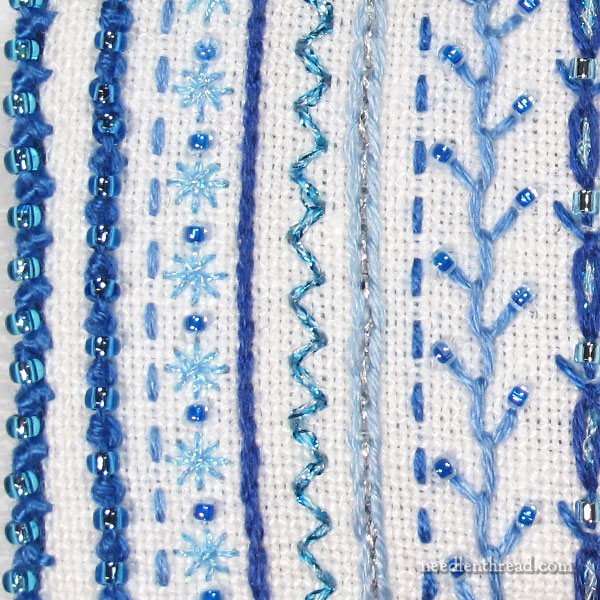
For those who would like to use beads to accent embroidery, I thought it would be nice to chat about thread.
Thread plays a big part in embroidery with beads – but there are different schools of thought on the types of threads that should be used to sew the beads onto embroidery.
Personally, I don’t adhere to any one school of thought on the subject, just as I don’t adhere to any one school of thought on the “right way” to form this stitch or that stitch. I tend to hold to the notion that there are many ways to accomplish the same results in embroidery, and that no one way is necessarily the only way or the right way.
Sure, some ways might be more efficient. And some might yield better results. But if efficiency isn’t your goal, and if your results are good, then what does it matter if you used one method or the other for forming a stitch?
That said, I like to know why I do things the way I do them, I like to be able to explain why I do them the way I do, and I like to experiment and try different ways, so that I know what I prefer and what works best for me.
It’s the same with choosing threads to sew beads onto embroidery projects. I’ve tried many different threads and many different ways, but I’ve pretty settled into the threads mentioned below. I’ll explain what they are and why I like them.

If you look at the close-ups of what are actually very small sampler-like pieces, you’ll see that there are two situations for the beads: either they are isolated in a sense, or they are part of a stitch.
When a bead is part of a stitch, it’s pretty obvious that the thread that’s fixing the bead to the fabric has to be the same thread used to embroider that particular stitch.
But when a bead is more isolated – when it isn’t part of an actual stitch – this is where you have room to decide what thread to use to fix the bead in place.
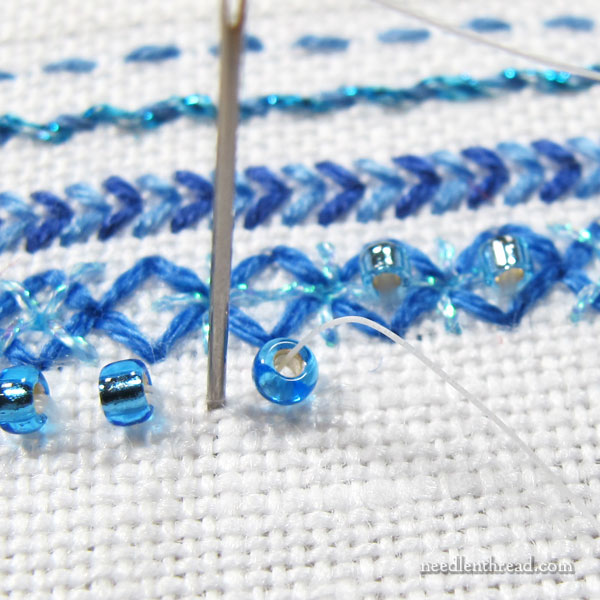
In the photo above, you’ll notice that the beads I’m sewing on are spaced apart from each other.
The thread I’m using isn’t really thread as we normally know it in embroidery. It looks a bit like plastic or something, doesn’t it?
In fact, it’s fishing line.
I like to use fishing line when I sew isolated beads onto an embroidery piece, and there are a few reasons for this.
1. Fishing line is, for all practical purposes, very difficult to see. It’s made to be difficult to see. When you’re fishing, after all, you need to be sneaky about it. You don’t want the fish to wonder why that delectable worm is hanging from that thread. They’d be on to you in no time.
If I’m working on white fabric, a white (or in this case, “clear mist”) colored line is practically invisible from a distance, once the bead is in place. It allows the bead to really show off its full color and finish.
2. Fishing line has a certain stiffness to it, that helps the beads stay put once they’re sewn on. For example, if your beads are meant to sit upright on the fabric (like a tire), fishing line helps that happen, and it helps them really stay in place.
3. It is completely invisible from the front, when it crosses the back of the fabric between the isolated beads.
4. It doesn’t stretch.
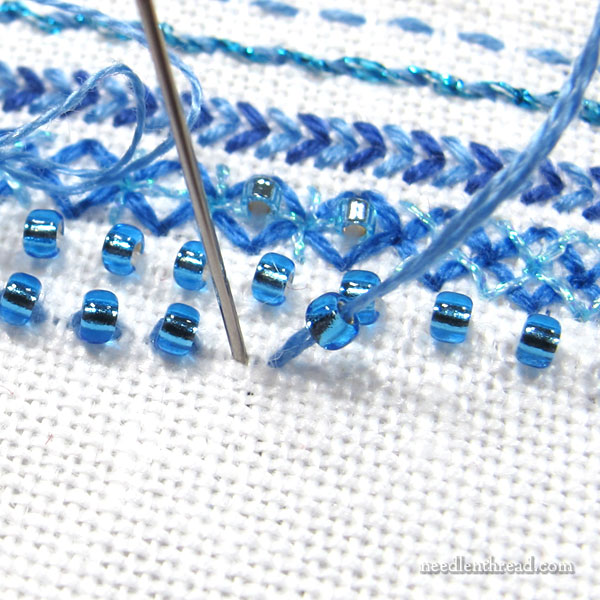
When sewing on isolated beads to accent embroidery, you can use a corresponding colored embroidery floss. There’s nothing wrong with this approach! But the colored threads show up a bit more, and they change the finished look of the bead. Often, the bead will look darker, especially if it has a transparent or crystal finish.
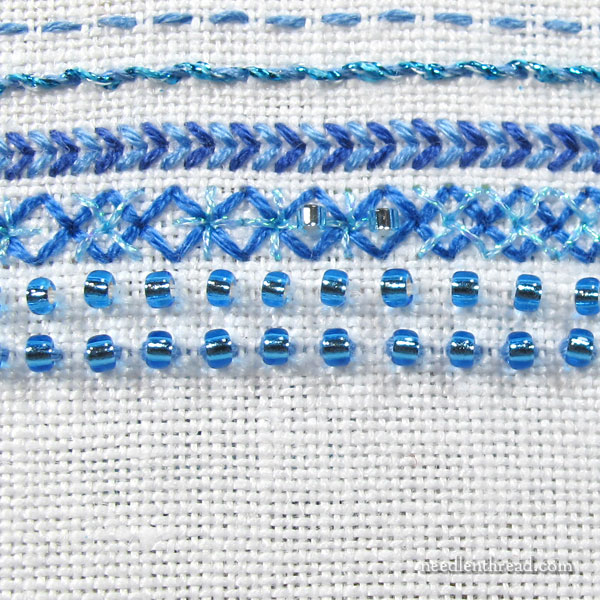
Embroidery floss can also make the bead look a little fatter, due to the little wings of floss sticking out on each side of the hole, where the floss passes through the bead and into the fabric.
In the photo above on the last two rows, the same beads are sewn down in parallel lines, but with different threads. The top row is sewn down with fishing line; the bottom row is sewn with floss. Notice that the bottom row of beads looks slightly darker and slightly fatter.
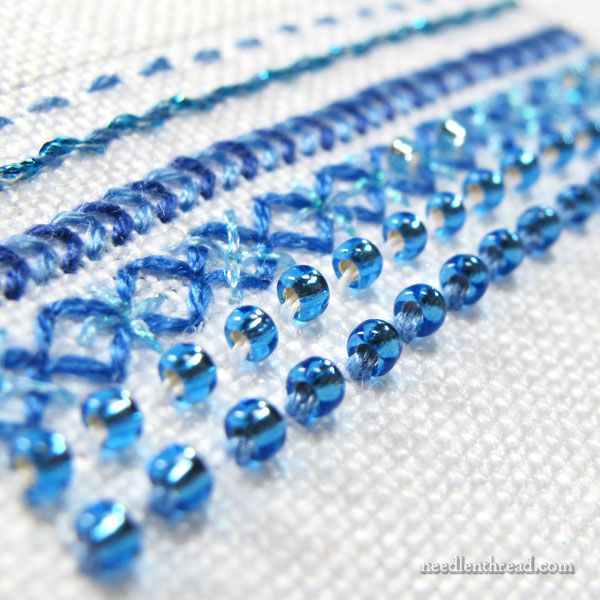
For the top row, using the fishing line, I passed through each bead three times. I use what is pretty much just a backstitch to sew beads into place in a separated row like this.
I passed through the beads in the bottom row twice, because my thread was doubled in the needle (that’s four strands passing through the middle of each bead).
I prefer the look of the top row over the bottom row.
Especially when I am sewing isolated beads, it’s important to me that the thread is as invisible as possible. I get the best invisibility from fishing line.
When I’m embroidering beads close together in rows, or when the beads are part of the embroidery stitches, or when I need colored thread to peep out of the beads for some reason or another, I’ll use the floss that goes with the project I’m stitching.
But for isolated beads, I really like fishing line!
This is what I used extensively on my Snowflake designs, since most of the beads are isolated quite a distance from each other. In the close up photos, you can see that the fishing line does not show through the fabric at all, and it holds the beads very firmly in place.
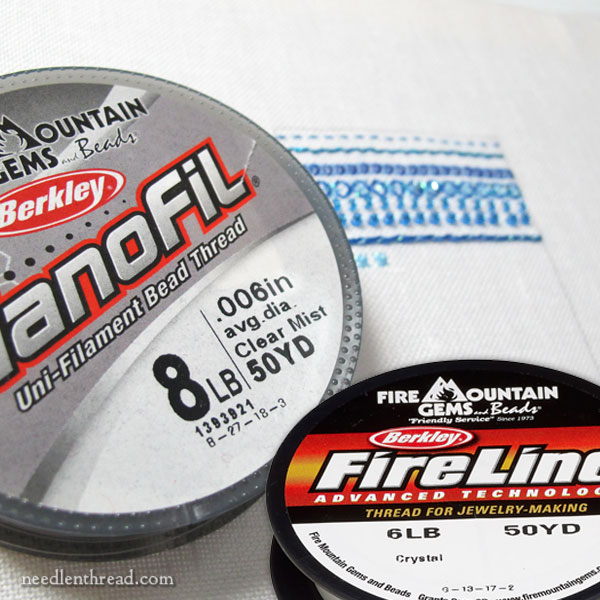
The fishing line I use is the stuff that’s sold for jewelry making with beads – either FireLine “crystal” (I like the 6lb test weight best for surface embroidery with beads) or NanoFil “mist” (I like the 8lb test weight in this line).
You can also use white silk thread to sew down beads on white fabric, but you don’t get the same “stiffness” in the fixation of the bead that you do with the fishing line. The fishing line really holds the bead firmly in place – so much so that it’s difficult to knock the bead around. It doesn’t flop over or turn in another direction very easily!
You can find both of these threads available through bead supply stores. They’re also available on Amazon, if you don’t have a favorite bead supply place. I’ve added them to my Amazon recommendations here, under Embroidery Tools & Accessories. A little goes a long way – you don’t need gargantuan amounts for embroidery with beads, so don’t go all out on hundreds of yards!
I hope that helps you out, if you’re keen to add beads here and there to your embroidery! I’ll be doing just that this weekend – and I’ll show you more results down the road!
Got Questions?
If you’re already generating questions in your head about using the fishing lines I’m talking about in this article, I followed up with another article that answers many questions. You can find Embroidery with Beads – Thread Follow-up here.
This article contains an affiliate link to my Amazon Recommendations page, which means that Needle ‘n Thread receives a small commission for any purchases made through that link, at no extra expense to you. Thanks!







Mary,
How do you end off fishing line since it is nylon and very slick?
I run it under the stitches just as I do embroidery thread. It doesn’t slip out if you give it a little hitch at the end.
In my experience of the fishing line for bead sewing–and other beading–there are different amounts of slickness to the various lines. I also like Fireline, which is a braided line that actually almost feels waxed. I ended my big bead embroidery project threads with the same back and forth in the back of the stitches that Ms. Mary recommends for regular embroidery threads.
I have some monofil 8 pound line, not Fireline, which is really slick. You have to work harder to get a firm knot. It is knottable–totally a word, or should be–after all, that’s how fishermen attach their hooks and weights to their pole. You might find yourself using fishermens’ knots instead of our smaller embroidery style knotting with it, I think.
Mary, I’m curious as to how you begin & end your stitching rows of beads with fishing line. If you were to use a knot would it not slip out or be bulky?
My husband is the master of fishing line in our house. I have access to his stash only when hanging Christmas decorations & detest the stuff. But it is invisible!
I start and end the threads exactly as i do with embroidery threads.
When you pass thru the bead 3 times, do you go thru the fabric each pass?
Also, how do you start and end stitching with fishing line?
Yes, you go through the fabric. I start and stop the same way as I do with embroidery thread.
When I first started beading I used Nymo thread, but after learning bead embroidery I’ve started using DMC thread, sewing thread or better yet the couching silk sold by the Japanese embroidery center.
I like Nymo as well…
Thank you for all the info on stitching with beads. I’ve heard of using fishing line but my experience with fishing line is that it tends to have a lot of spring to it. I couldn’t imaging keeping it taut as I added a bead. Now I see you use line specifically for beading. Time to check it out. 🙂 I’ve always used floss and for the reasons you mentioned: it intensifies the bead color and it rounds out the bead. Without it, the beads look like pieces of tube (straws) sitting on the fabric. Perfectly round beads are hard to find. In any case, I’ll look for the line you use and try it out.
The springiness, I think, is a product of the weight. The 6 pound line is often the lightest line in the shop. The other spools of the same brand can be 20, 30, etc. pound line and they’re thicker and stiffer.
For a cheaper source of Fireline, go to Walmart (shudder) and go to the fishing and hunting section. The Fireline is the exact same thing as sold through the beading places, and half the price. While I much prefer patronizing small business, if you’re on a budget, it’s there.
Even sporting goods stores (any place with a fishing section, really) will carry Fireline and/or Nanofil. Since it’s not directed at specialty bead workers and used in larger quantities by folks trying to catch fish, it’s almost always cheaper from those stores than a bead supply like Fire Mountain. As an example, right now a 50yd spool at FM is currently ~$12, but a 125yd spool at Dick’s is ~$18, with the benefit that you’ll be buying less often and tossing fewer empty spools if you’re using enough of it!
Good point!
I have been told that bead edges can be sharp so regular embroidery floss may not hold up as well as that specifically made for beading. Probably wouldn’t be a problem for something like a sampler that would be stationary. Most projects I have sewn say to add the beads last, perhaps for that very reason.
Loved the comment about Walmart (shudder)
Would love to know how you”tie off” make a secure knot with fishing line/ monofilament. I like the idea of not seeing thread and that the beads stand up independently. Thanks for your videos I refer to them often.
Thanks for covering this, Mary. I’ve used Fireline and Wildfire for making beaded jewelery such as bracelets and earrings but have added beads to only a few bits of embroidery so far. But I’ve got more beads than I know what to do with so I’ve been mulling over a few embroidery ideas and started wondering about this very subject.
I will note that another advantage to using a braided fused fishing line like Fireline or Wildfire is that it is fray-resistant. If your glass beads happen to have sharp edges at the openings, ordinary thread or floss can be badly worn or cut through by the edges, even just while stitching in the hoop. Good quality beads shouldn’t be a problem, but even good quality bicone beads, and many off-brand/budget, vintage, or bugle (longer, tube-shaped) beads can be particularly prone to this even if they don’t look sharp. (Beaders and bead embroiderers sometimes place a seed bead at each end of a bugle bead to prevent the thread from coming in contact with the ends of the bugle bead.)
Wildfire (sold as a beading thread) comes in a few more colors (some say the green actually works well as a neutral, though I haven’t tried it). Fireline comes in more sizes, but I can’t imagine needing anything bigger than what you’re using; though sold in beading/craft stores, Fireline’s often priced lower in sporting goods depts/stores.
Also, because they are designed not to break, these products can be very, very hard on your scissors even in the finer sizes (some beaders use scissors made of kevlar or special thread-burners), so spare your fine embroidery scissors!
Your samples are lovely! Will we be seeing more of them?
Dear Mary
I love bead embroidery or embroidery with beads as I think, like you, beads enhance the look of the piece and you can see the difference between isolation and part of an embroidery piece. That’s really interesting about using fishing line to sew on beads what a good idea and you can see the difference between threads and fishing line on beads. I never thought to use fishing line threads as part of my embroidery but will consider it in the future. I’m really looking forward to your projects on beads and embroidery I hope you have a great stitching weekend.Thank you for sharing with us fishing line threads and how to use it on beads.
Regards Anita Simmance
Thanks so much for this article Mary, like you I love beads! I’ve tried these types of threads to good result, but for the last few years I’ve been relying on the quilter’s friend – invisible thread. I find it much easier to work with, especially when starting and stopping – it darns like thread, no need to knot it. My favourite right now is Coats Transparent, but the Sulky is good too (and also comes in grey and black). It’s not as firm but still has an extra stiffness compared to sewing thread. Love those samplers!
I am wondering what the background fabric you are using with the beads. Thank You!
Linen! it’s my go-to fabric – most of the embroidery you’ll see on NNT is done on linen. 🙂
A really useful article, yet again, Mary. Thank you so much. Stay safe.
Okay, dear Mary, but I have a “yes, but”: whatever you are embroidering, if it gets pressed with a hot iron, won’t the fishing line melt? I am a beader and lover of all these things. I would prefer to add beads with poly or poly-cotton sewing thread. I think the item would more likely hold up well, especially if it is a gift. Quilters know how to choose thread color, compromising often. It just has to be done! And if the threads are pulled tightly in placing the beads, the work should look great.
I don’t usually have to press my small things like ornaments and such. I usually damp stretch my embroidery. But if I were sewing something that had beads on it and that was meant for regular laundering and pressing, like a garment or a quilt, I’d use regular thread.
Hi Mary,
I just wanted to drop you a line and say how much I’m enjoying your blog! Every article I read expands my understanding of the world of embroidery. You make me laugh and teach me so, so much. From a novice’s perspective, resources like this are invaluable and I’m just so grateful that you take the time to create this blog. Thank you!
Cheers,
Francesca
🙂 Thanks, Francesca!
Seconded, Francesca! It’s always a delight to read and I never fail to learn something new. Thanks Mary.
You didn’t mention this in today’s posting and perhaps I missed it earlier, but the reason to not buy fishing line at the sporting goods store is that the version they sell was reformulated to degrade over time to protect the environment. Only the product sold for beading/crafts is the kind that will stand up over time.
For me there’s a different between bead embroidery and embroidery with beads. Bead embroidery is when the surface is mostly covered with beads and often cabs. Embroidery with beads is the pictures you have in this post where the thread is a prominent feature. Here’s an example of one of my bead embroidery pendants https://www.facebook.com/photo?fbid=10218841098845187&set=a.1969838972307 .
I use Fireline in my beadwork and a surgeons knot will hold pretty well and then I run it though other beads or skim the surface of the back of the fabric. I use white glue to make it lie flat. FireLine doesn’t work for fringe as it’s too stiff. You can search for “fishing line knots” and there are lots that will hold.
For bead embroidery I like OneG best and KO second best. I don’t use nymo anymore because it’s frays so much.
I am going to add several beads to the neckline of a blouse for the first time! I bought stretchy beading thread because it was the only clear thread I noticed. I plan on having the beads spaced out, so I’ll be adding them separately. Stretchy is no good? Should I get a different kind of thread?